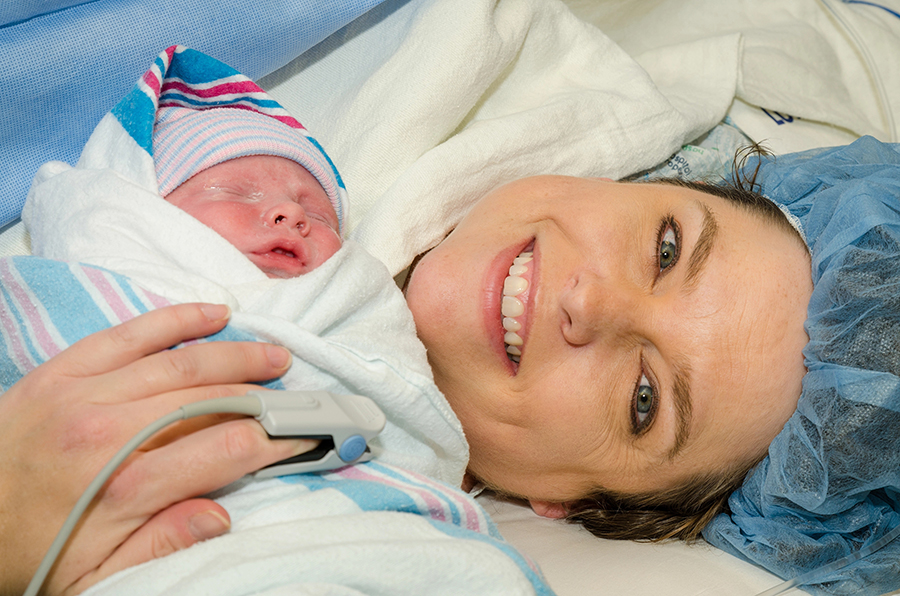If you’ve had at least one C-section, you may want to know if you can try for a vaginal delivery with your next baby. Studies have shown that vaginal birth after cesarean (VBAC) has a success rate of 60% to 80%. Call us today 954-507-4604 about your risks for each delivery method and how you want to give birth.


What is a VBAC in pregnancy?
A vaginal birth after cesarean or VBAC is when you give birth through your vagina after previously having a C-section (cesarean section) delivery. A C-section involves your pregnancy care provider making a surgical cut (incision) through your belly and uterus to deliver your baby.
The goal of a VBAC is to give a person who had a C-section the chance to have a vaginal delivery for their next pregnancy. It can sometimes be unsafe to have a vaginal delivery after having one or more C-section deliveries.
The decision on whether to attempt a VBAC involves considering factors like:
- The type of incision your surgeon used for your C-section(s) and if you have had more than one C-section.
- Your health history.
- If you have any medical conditions.
- The position of the fetus and if the fetus has any known medical conditions.
Your pregnancy care provider will tell you if they believe a VBAC is safe to try. They can discuss potential risks and benefits with you. Then, you can choose if you’d like to pursue a VBAC or have another C-section based on your discussions.
Studies show that up to 75% of people who had one C-section went on to have a successful vaginal birth in their next pregnancy. But your chance of having a successful VBAC drops to about 50% if you’ve had two or more prior C-section deliveries.
Healthcare providers sometimes refer to a VBAC as a trial of labor after cesarean (TOLAC). A TOLAC is an attempt to have a VBAC. If a TOLAC is successful, the result is a VBAC. If it’s not successful, the result is another C-section delivery.
Why do people prefer a VBAC instead of another C-section?
It’s mostly a personal preference. Some people prefer a vaginal delivery, but for some reason, they haven’t been able to have one. Or a person might prefer a vaginal delivery because recovering from a C-section typically takes longer.
Even if you want a vaginal delivery, your healthcare provider may recommend another C-section due to the risks of a VBAC. Or they may tell you it’s OK to try for a VBAC.
What are the benefits of VBAC?
The benefits of VBAC compared to a C-section include:
- Faster recovery and shorter hospital stay.
- No abdominal surgery.
- Avoiding or lowering C-section risks like heavy bleeding and infection.
- Vaginal birth helps clear amniotic fluid from your baby’s lungs as it passes through the birth canal. This better prepares your baby to breathe oxygen after birth.
- Your baby gets an immune system boost as it travels through the birth canal during a vaginal delivery.
- Less risk of complications from repeat surgeries like scarring or injuries to nearby organs.
- Personal preference. Some people want the experience of a vaginal birth.
What are the risks of a VBAC?
Because a C-section leaves a scar on your uterus, the pressure of labor could cause your uterus to open (rupture) along your C-section scar. But recent studies show it’s possible to have a safe VBAC after having a C-section in most cases.
Although rare, a uterine rupture is a serious complication that can have life-threatening results. If you’re at a high risk for uterine rupture, your healthcare provider will typically not attempt a VBAC.
Other risks of attempting a VBAC are:
- Blood loss.
- Infection.
- Emergency C-section (which is riskier than a planned C-section).
What’s the risk of a uterine rupture if you’ve had a previous C-section?
The risk of uterine rupture if you’ve had a C-section with a transverse cut (sideways across the lower part of the uterus) is about 0.9% or slightly less than 1 in 100.
Does the type of incision I got from my last C-section matter if I want a VBAC?
Yes. There are different types of C-section incisions:
- A low transverse incision has the lowest risk of uterine rupture. This horizontal cut is made across the lower, thinner part of your uterus.
- A low vertical incision (up and down cut) has a higher risk of rupture than a low transverse incision. This vertical cut is made in the lower, thinner part of your uterus.
- A high vertical incision (“classical” incision) in the upper part of your uterus has the highest risk of uterine rupture. Surgeons may need to use this type of incision for a premature baby or one that’s in a difficult position to deliver.
The location and direction of the outer incision on your belly doesn’t mean that the incision in your uterus is in the same location or the same direction. For example, it may appear that the scar on your belly is transverse, yet the scar on your uterus is vertical.
The information about the location and direction of the incision on your uterus should be in your medical records. When you talk about how safe VBAC is with your provider, make sure they look at your medical records and the reasons for any C-sections you’ve had.
Is a VBAC safer than a repeat C-section?
Talk with your healthcare provider about your health history, current pregnancy and why you had a C-section in your last pregnancy.
Your chances of having a successful VBAC may be higher if you:
- Have had previous C-section deliveries (one or two) with low transverse incisions.
- Have had a vaginal birth before.
- Haven’t had any other uterine surgeries (such as fibroid removal, also called myomectomy).
- Have no history of uterine rupture.
- Don’t have a medical condition (like fibroids or problems with the location of your placenta) that makes a vaginal delivery risky.
- Go into labor on your own before your due date.
If you’ve already had a successful VBAC — without complications such as ruptured uterus — you’re more likely to have successful future vaginal deliveries.
Your chances of having a successful VBAC may be lower if you:
- Had a prior C-section due to labor not progressing. This means you didn’t dilate (cervix opens) or efface (cervix shortens) during a vaginal delivery.
- Are older than 35.
- Have obesity or overweight.
- Are giving birth to a large fetus or expecting multiples.
- Are past your due date.
- Had a baby within the last 18 months (short time between pregnancies).
- Have preeclampsia. (Healthcare providers may prefer a C-section delivery.)
What are the risks of multiple C-sections?
There isn’t a set number of C-sections you can have. But some evidence shows that people who have many C-sections are at a higher risk for:
- Heavy bleeding.
- Bladder and bowel injury.
- Infection.
- Placental conditions like placenta previa or placenta accreta in a future pregnancy where the placenta is abnormally attached.
- Uterine rupture.
- Adhesions (scarring).
These risks vary and depend mostly on your health history and the specific circumstances of each pregnancy and delivery. Your healthcare provider is the best person to talk to about the risks and benefits of a repeat C-section versus a VBAC.
What questions should I ask my healthcare provider about VBAC and repeat C-sections?
Both vaginal birth after cesarean (VBAC) and C-sections have risks and benefits. It’s important to discuss the pros and cons of each delivery so you understand each type and what it means for you.
Topics to discuss with your pregnancy care provider include:
- Past pregnancies and deliveries.
- Reason(s) you had a C-section.
- Safety of VBAC and a repeat C-section for you and your baby.
- Reasons you should or shouldn’t consider VBAC.
- Reasons you should or shouldn’t consider repeat C-section.
- A plan for inducing labor (or not).
- If the healthcare facility can manage emergency deliveries.
- Your plan for more children.


